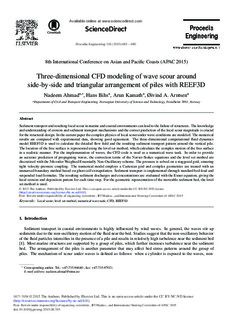| dc.contributor.author | Ahmad, Nadeem | |
| dc.contributor.author | Bihs, Hans | |
| dc.contributor.author | Kamath, Arun | |
| dc.contributor.author | Arntsen, Øivind Asgeir | |
| dc.date.accessioned | 2017-11-17T11:55:56Z | |
| dc.date.available | 2017-11-17T11:55:56Z | |
| dc.date.created | 2015-09-15T11:32:57Z | |
| dc.date.issued | 2015 | |
| dc.identifier.citation | Procedia Engineering. 2015, 116 (1), 683-690. | nb_NO |
| dc.identifier.issn | 1877-7058 | |
| dc.identifier.uri | http://hdl.handle.net/11250/2466955 | |
| dc.description.abstract | Sediment transport and resulting local scour in marine and coastal environments can lead to the failure of structures. The knowledge and understanding of erosion and sediment transport mechanisms and the correct prediction of the local scour magnitude is crucial for the structural design. In the current paper the complex physics of local scour under wave conditions are modeled. The numerical results are compared with experimental data, showing good agreement. The three-dimensional computational fluid dynamics model REEF3D is used to calculate the detailed flow field and the resulting sediment transport pattern around the vertical pile. The location of the free surface is represented using the level set method, which calculates the complex motion of the free surface in a realistic manner. For the implementation of waves, the CFD code is used as a numerical wave tank. In order to provide an accurate prediction of propagating waves, the convection terms of the Navier-Stokes equations and the level set method are discretized with the 5th-order Weighted Essentially Non-Oscillatory scheme. The pressure is solved on a staggered grid, ensuring tight velocity-pressure coupling. The numerical model employs a Cartesian grid and complex geometries are treated with an immersed boundary method based on ghost cell extrapolation. Sediment transport is implemented through standard bed-load and suspended load formulas. The resulting sediment discharges and concentrations are evaluated with the Exner equation, giving the local erosion and deposition pattern for each time step. For the geometric representation of the moveable sediment bed, the level set method is used. | nb_NO |
| dc.language.iso | eng | nb_NO |
| dc.publisher | Elsevier | nb_NO |
| dc.rights | Attribution-NonCommercial-NoDerivatives 4.0 Internasjonal | * |
| dc.rights.uri | http://creativecommons.org/licenses/by-nc-nd/4.0/deed.no | * |
| dc.title | Three-dimensional CFD modeling of wave scour around side-by-side and triangular arrangement of piles with REEF3D | nb_NO |
| dc.type | Journal article | nb_NO |
| dc.type | Peer reviewed | nb_NO |
| dc.description.version | publishedVersion | nb_NO |
| dc.source.pagenumber | 683-690 | nb_NO |
| dc.source.volume | 116 | nb_NO |
| dc.source.journal | Procedia Engineering | nb_NO |
| dc.source.issue | 1 | nb_NO |
| dc.identifier.doi | 10.1016/j.proeng.2015.08.355 | |
| dc.identifier.cristin | 1264276 | |
| dc.relation.project | Norges forskningsråd: 65027900 | nb_NO |
| dc.relation.project | Notur/NorStore: NN2620K | nb_NO |
| dc.description.localcode | © 2015 The Authors. Published by Elsevier Ltd. This is an open access article under the CC BY-NC-ND license (http://creativecommons.org/licenses/by-nc-nd/4.0/) | nb_NO |
| cristin.unitcode | 194,64,91,0 | |
| cristin.unitname | Institutt for bygg- og miljøteknikk | |
| cristin.ispublished | true | |
| cristin.fulltext | postprint | |
| cristin.qualitycode | 1 | |

